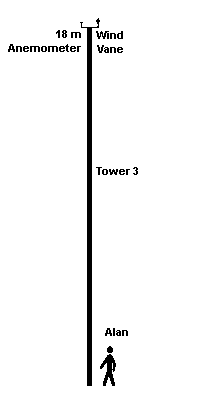|
18m Anemometer
Read all about it here...

 About Anemometers
About Anemometers
The 18m Anemometer is mounted 18m above the ground, on tower 3.
 We use cup anemometers to measure wind speed. As the wind blows the cups rotate and so spin the vertical spindle – the faster the wind is blowing the faster the spindle turns. The speed of rotation is measured in two different ways – in one a slotted disc is attached to the base of the spindle and number of slots “seen” by a sensor during a minute is counted, the number of counts converted into a wind speed value – this gives the average speed during the minute. In the second method the spindle drives a small generator – the voltage is directly linked to the speed of rotation (and thus the wind speed) – this instrument therefore gives an instantaneous measure of the speed. The ERU Test Site instruments all use the slotted disk method, and measure the average speed during the previous minute. They come from
Vector Instruments
. We use cup anemometers to measure wind speed. As the wind blows the cups rotate and so spin the vertical spindle – the faster the wind is blowing the faster the spindle turns. The speed of rotation is measured in two different ways – in one a slotted disc is attached to the base of the spindle and number of slots “seen” by a sensor during a minute is counted, the number of counts converted into a wind speed value – this gives the average speed during the minute. In the second method the spindle drives a small generator – the voltage is directly linked to the speed of rotation (and thus the wind speed) – this instrument therefore gives an instantaneous measure of the speed. The ERU Test Site instruments all use the slotted disk method, and measure the average speed during the previous minute. They come from
Vector Instruments
.
Cup anemometers do not measure low speeds very accurately and indeed at very low speed do not turn at all and thus give a false reading of zero. They also do not give accurate readings when it is very cold (as the spindle can freeze up) or during snow (as the cups can fill up with snow).
ERU has three anemometers set at different heights as wind speed increases the higher from the ground that you measure it. This is the
Wind Gradient
.
Wind speed is measured by us in metres per second (m/s). This
Met Office table
converts these values into miles per hour, knots (a unit of measurement used by sailors – a nautical mile per hour) and the
Beaufort scale
(used by Met Offices – for example “Storm Force 10”), and gives brief descriptions of what this means for conditions at sea, and this
Royal Meteorological Society table
does the same for land conditions.
As a very rough guide you need to double the m/s value to get the equivalent mph figure
Kite Surf has an
online wind speed converter
into a variety of units
|




 We use cup anemometers to measure wind speed. As the wind blows the cups rotate and so spin the vertical spindle – the faster the wind is blowing the faster the spindle turns. The speed of rotation is measured in two different ways – in one a slotted disc is attached to the base of the spindle and number of slots “seen” by a sensor during a minute is counted, the number of counts converted into a wind speed value – this gives the average speed during the minute. In the second method the spindle drives a small generator – the voltage is directly linked to the speed of rotation (and thus the wind speed) – this instrument therefore gives an instantaneous measure of the speed. The ERU Test Site instruments all use the slotted disk method, and measure the average speed during the previous minute. They come from
We use cup anemometers to measure wind speed. As the wind blows the cups rotate and so spin the vertical spindle – the faster the wind is blowing the faster the spindle turns. The speed of rotation is measured in two different ways – in one a slotted disc is attached to the base of the spindle and number of slots “seen” by a sensor during a minute is counted, the number of counts converted into a wind speed value – this gives the average speed during the minute. In the second method the spindle drives a small generator – the voltage is directly linked to the speed of rotation (and thus the wind speed) – this instrument therefore gives an instantaneous measure of the speed. The ERU Test Site instruments all use the slotted disk method, and measure the average speed during the previous minute. They come from